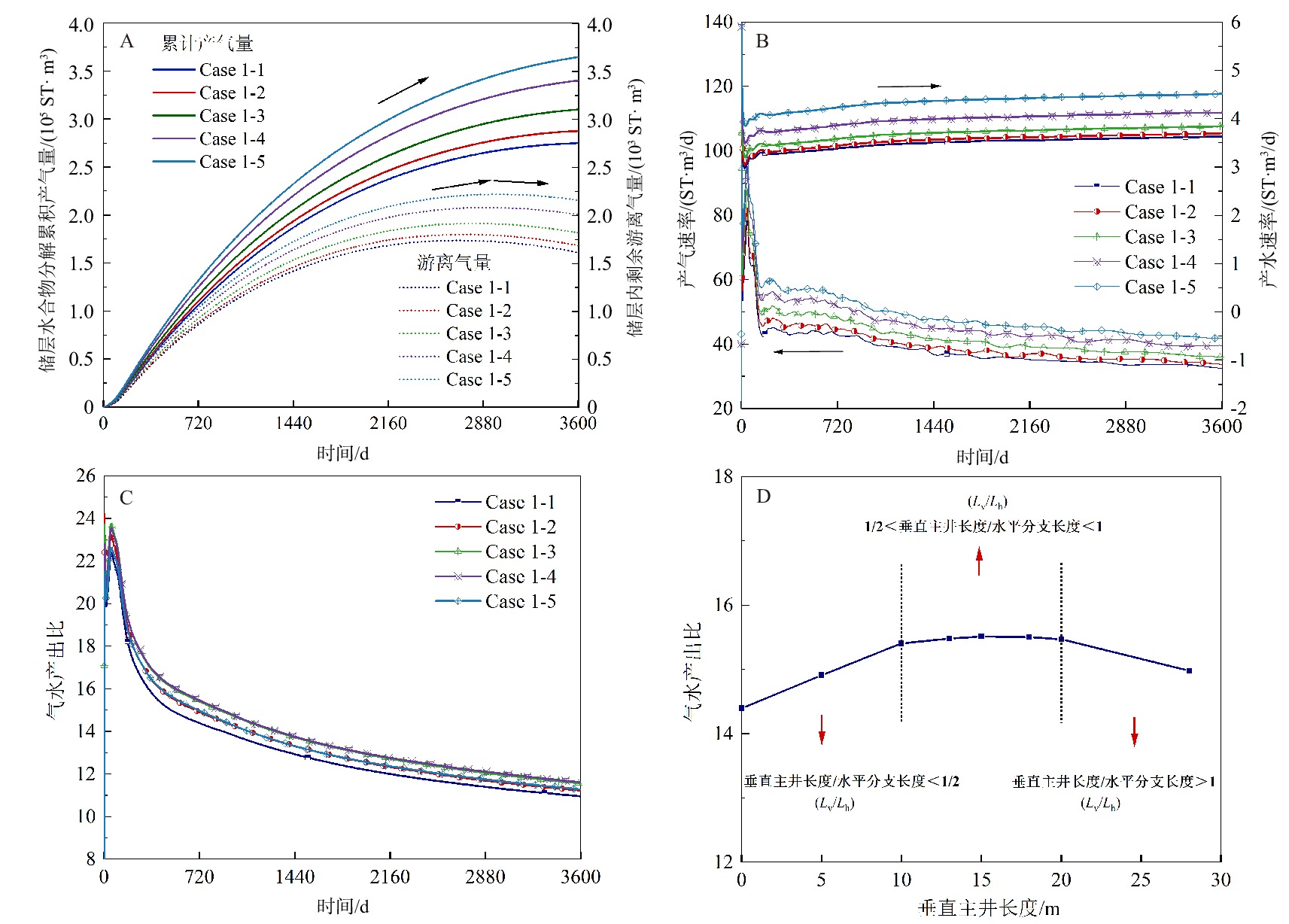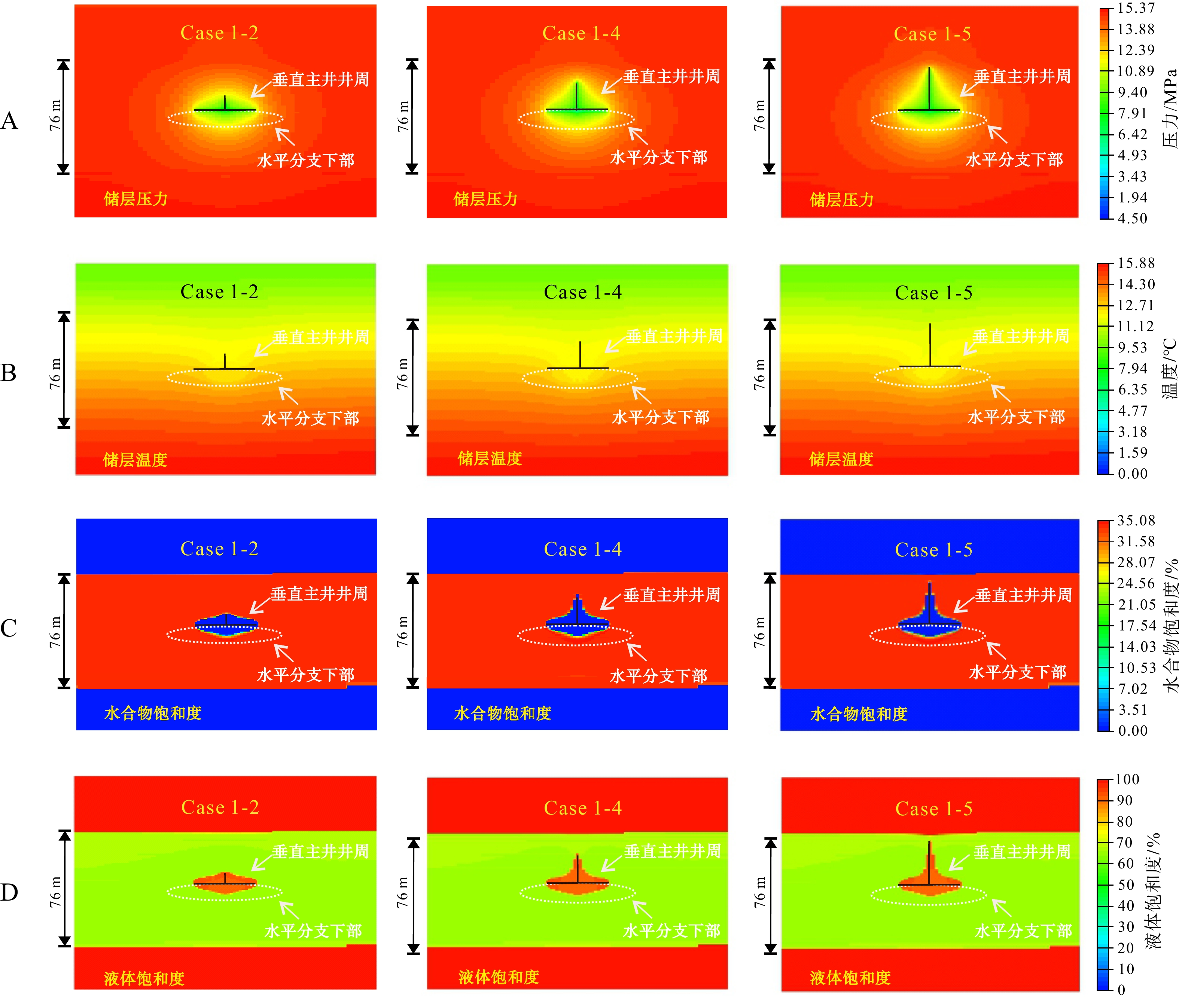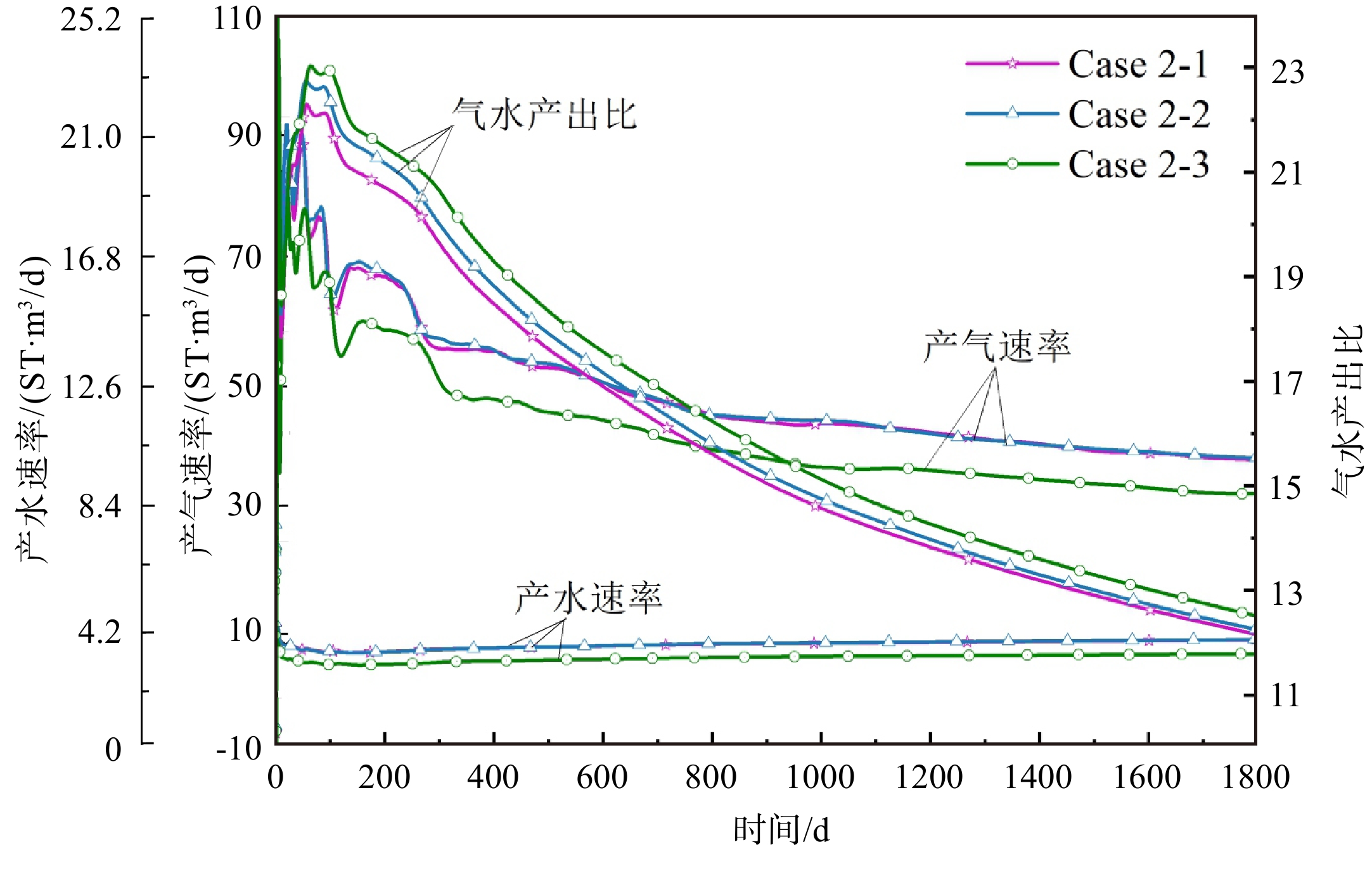Effects of perforation degree and deployment position of multilateral horizontal wells on gas production from inclined clay hydrate reservoirs
-
摘要:
南海天然气水合物(以下简称水合物)较多赋存于凹凸起伏的泥质地层中。针对实际倾斜水合物储层展开多分支井产能研究十分必要。以南海北部神狐海域X01站位实际地质参数和地形参数为依据,利用TOUGH+HYDRATE水合物产能预测软件和经过验证的建模新方法,建立了代表实际情况的倾斜泥质水合物储层模型,探讨了多分支井射孔程度对开采产能的影响,对比了位于储层不同构造位置(即构造低部位、倾斜部位和构造高部位)的多分支井的产能差异,确定了优势开采井型和最佳布井位置。结果表明,相比于仅水平分支射孔的多分支井,水平分支和垂直主井同时射孔的多分支井更利于水合物分解产气。但垂直主井的打开长度不宜过长,垂直主井与水平分支的打开长度比值介于0.5~1.0最利于提高气水产出比。泥质水合物储层的地层倾角影响多分支井的开采产能,将多分支井布设在储层构造低部位的水平位置更利于实现水合物长期高效开采。
Abstract:Natural gas hydrate (NGH) is generally disseminated in inclined mud sediments in South China Sea (SCS), China. It is of great significance to investigate the production performance of multilateral horizontal wells in actual inclined NGH reservoirs. We implemented a real 3D inclined clay hydrate reservoir model based on geological and topographical data from the site X01, Shenhu Area, SCS, to simulate the production performance of multilateral horizontal wells with TOUGH+HYDRATE software and verified the modeling method. We studied the effects of perforation degree on the production performance of multilateral horizontal wells. The differences in production were compared when multilateral horizontal wells were deployed at different tectonic settings of NGH reservoirs (i.e., structural high position, inclined position, and structural low position). The optimal well configuration and placement position were determined. Results show that multilateral horizontal wells that are perforated simultaneously in horizontal branch and vertical main well are beneficial to enhance NGH dissociation and gas production. However, the perforation section of vertical main wells should not be too long. The optimal length ratio of vertical main well and horizontal branch is 0.5~1.0. Moreover, the inclination of the hydrate reservoirs affects significantly the production performance of multilateral horizontal wells. Comparatively, deploying multilateral horizontal wells at horizontal places at low structural positions of clay hydrate reservoirs is conducive to long-term and efficient production of NGH.
-

-
参数 数值 参数 数值 储层基础参数 上覆盖层厚度/m 116.5 颗粒密度/(kg∙m−3) 2650 水合物储层厚度/m 76 地温梯度/(℃/100 m) 5.46 下伏地层厚度/m 120 热导率(湿)/(W∙m−1∙℃) 2.917 储层孔隙度/% 34.50 热导率(干)/(W∙m−1∙℃) 1.00 储层绝对渗透率/(10−3μ㎡) kx = ky = kz = 0.22 压缩系数/Pa−1 1.00×10−8 水合物饱和度/% 34.00 比热容/(J∙kg−1∙℃−1) 1000 X01站位处水深/m 1309.75 孔隙水盐度/‰ 3.05 相对渗透率模型(Relative permeability model) [39] KrA =(SA*)n KrG =(SG*)nG SA*=(SA−SirA)/(1−SirA) SG* =(SG −SirG)/(1−SirA) SirA 0.50 nG 3.00 SirG 0.05 n 5.00 孔隙水压力模型(Capillary pressure model) [42] Pcap = −P0[(S*)−1/λ−1]1−λ S* =(SA−SirA)/(SmxA−SirA) P0/Pa 105 SmxA 1.00 λ 0.15 SirA 0.50 -
[1] Boswell R. Is gas hydrate energy within reach? [J]. Science, 2009, 325(5943): 957-958. doi: 10.1126/science.1175074
[2] Li J F, Ye J L, Qin X W, et al. The first offshore natural gas hydrate production test in South China Sea [J]. China Geology, 2018, 1(1): 5-16. doi: 10.31035/cg2018003
[3] 叶建良, 秦绪文, 谢文卫, 等. 中国南海天然气水合物第二次试采主要进展[J]. 中国地质, 2020, 47(3):557-568 doi: 10.12029/gc20200301
YE Jianliang, QIN Xuwen, XIE Wenwei, et al. Main progress of the second gas hydrate trial production in the South China Sea [J]. Geology in China, 2020, 47(3): 557-568. doi: 10.12029/gc20200301
[4] 刘昌岭, 李彦龙, 孙建业, 等. 天然气水合物试采: 从实验模拟到场地实施[J]. 海洋地质与第四纪地质, 2017, 37(5):12-26
LIU Changling, LI Yanlong, SUN Jianye, et al. Gas hydrate production test: from experimental simulation to field practice [J]. Marine Geology & Quaternary Geology, 2017, 37(5): 12-26.
[5] 吴能友, 李彦龙, 万义钊, 等. 海域天然气水合物开采增产理论与技术体系展望[J]. 天然气工业, 2020, 40(8):100-115 doi: 10.3787/j.issn.1000-0976.2020.08.008
WU Nengyou, LI Yanlong, WAN Yizhao, et al. Prospect of marine natural gas hydrate stimulation theory and technology system [J]. Natural Gas Industry, 2020, 40(8): 100-115. doi: 10.3787/j.issn.1000-0976.2020.08.008
[6] Wang Y, Feng J C, Li X S, et al. Influence of well pattern on gas recovery from methane hydrate reservoir by large scale experimental investigation [J]. Energy, 2018, 152: 34-45. doi: 10.1016/j.energy.2018.03.126
[7] Wang Y, Feng J C, Li X S. Experimental investigation into methane hydrate dissociation by thermal stimulation with dual vertical well [J]. Energy Procedia, 2017, 105: 4738-4744. doi: 10.1016/j.egypro.2017.03.1031
[8] Wang Y, Li X S, Li G, et al. A three-dimensional study on methane hydrate decomposition with different methods using five-spot well [J]. Applied Energy, 2013, 112: 83-92. doi: 10.1016/j.apenergy.2013.05.079
[9] Zhao E M, Hou J, Liu Y G, et al. Enhanced gas production by forming artificial impermeable barriers from unconfined hydrate deposits in Shenhu area of South China sea [J]. Energy, 2020, 213: 118826. doi: 10.1016/j.energy.2020.118826
[10] Zhao J F, Liu Y L, Guo X W, et al. Gas production behavior from hydrate-bearing fine natural sediments through optimized step-wise depressurization [J]. Applied Energy, 2020, 260: 114275. doi: 10.1016/j.apenergy.2019.114275
[11] 吴能友, 黄丽, 胡高伟, 等. 海域天然气水合物开采的地质控制因素和科学挑战[J]. 海洋地质与第四纪地质, 2017, 37(5):1-11
WU Nengyou, HUANG Li, HU Gaowei, et al. Geological controlling factors and scientific challenges for offshore gas hydrate exploitation [J]. Marine Geology & Quaternary Geology, 2017, 37(5): 1-11.
[12] Feng J C, Wang Y, Li X S, et al. Effect of horizontal and vertical well patterns on methane hydrate dissociation behaviors in Pilot-scale hydrate Simulator [J]. Applied Energy, 2015, 145: 69-79. doi: 10.1016/j.apenergy.2015.01.137
[13] Myshakin E M, Ajayi T, Anderson B J, et al. Numerical simulations of depressurization-induced gas production from gas hydrates using 3-D heterogeneous models of L-Pad, Prudhoe Bay Unit, North Slope Alaska [J]. Journal of Natural Gas Science and Engineering, 2016, 35: 1336-1352. doi: 10.1016/j.jngse.2016.09.070
[14] Wu N Y, Li Y L, Wan Y Z, et al. Prospect of marine natural gas hydrate stimulation theory and technology system [J]. Natural Gas Industry B, 2021, 8(2): 173-187. doi: 10.1016/j.ngib.2020.08.003
[15] 陈强, 胡高伟, 李彦龙, 等. 海域天然气水合物资源开采新技术展望[J]. 海洋地质前沿, 2020, 36(9):44-55
CHEN Qiang, HU Gaowei, LI Yanlong, et al. A prospect review of new technology for development of marine gas hydrate resources [J]. Marine Geology Frontiers, 2020, 36(9): 44-55.
[16] Li Y L, Wan Y Z, Chen Q, et al. Large borehole with multi-lateral branches: a novel solution for exploitation of clayey silt hydrate [J]. China Geology, 2019, 2(3): 331-339. doi: 10.31035/cg2018082
[17] Xin X, Li S, Xu T F, et al. Numerical investigation on gas production performance in methane hydrate of multilateral well under depressurization in Krishna-Godavari Basin [J]. Geofluids, 2021, 2021: 9936872.
[18] Mao P X, Wan Y Z, Sun J X, et al. Numerical study of gas production from fine-grained hydrate reservoirs using a multilateral horizontal well system [J]. Applied Energy, 2021, 301: 117450. doi: 10.1016/j.apenergy.2021.117450
[19] Huang L, Su Z, Wu N Y, et al. Analysis on geologic conditions affecting the performance of gas production from hydrate deposits [J]. Marine and Petroleum Geology, 2016, 77: 19-29. doi: 10.1016/j.marpetgeo.2016.05.034
[20] Moridis G J. Numerical studies of gas production from Class 2 and Class 3 hydrate accumulations at the Mallik Site, Mackenzie Delta, Canada [J]. SPE Reservoir Evaluation & Engineering, 2004, 7(3): 175-183.
[21] Reagan M T, Moridis G J, Zhang K N. Sensitivity analysis of gas production from Class 2 and Class 3 hydrate deposits[C]//Offshore Technology Conference. Houston, Texas, USA, 2008.
[22] Su Z, Moridis G J, Zhang K N, et al. A huff-and-puff production of gas hydrate deposits in Shenhu area of South China Sea through a vertical well [J]. Journal of Petroleum Science and Engineering, 2012, 86-87: 54-61. doi: 10.1016/j.petrol.2012.03.020
[23] Sun J X, Ning F L, Zhang L, et al. Numerical simulation on gas production from hydrate reservoir at the 1st offshore test site in the eastern Nankai Trough [J]. Journal of Natural Gas Science and Engineering, 2016, 30: 64-76. doi: 10.1016/j.jngse.2016.01.036
[24] Chen L, Feng Y C, Merey S, et al. Numerical investigation on gas production from Shenhu (China): Influence of layer inclination and horizontal Inhomogeneities [J]. Journal of Natural Gas Science and Engineering, 2020, 82: 103509. doi: 10.1016/j.jngse.2020.103509
[25] Xia Y L, Xu T F, Yuan Y L, et al. Effect of perforation interval design on gas production from the validated hydrate-bearing deposits with layered heterogeneity by depressurization [J]. Geofluids, 2020, 2020: 8833884.
[26] Mao P X, Sun J X, Ning F L, et al. Numerical simulation on gas production from inclined layered methane hydrate reservoirs in the Nankai Trough: A case study [J]. Energy Reports, 2021, 7: 8608-8623. doi: 10.1016/j.egyr.2021.03.032
[27] Yuan Y L, Xu T F, Xia Y L, et al. Effects of formation dip on gas production from unconfined marine hydrate-bearing sediments through depressurization [J]. Geofluids, 2018, 2018: 5836293.
[28] Song B J, Cheng Y F, Yan C L, et al. Seafloor subsidence response and submarine slope stability evaluation in response to hydrate dissociation [J]. Journal of Natural Gas Science and Engineering, 2019, 65: 197-211. doi: 10.1016/j.jngse.2019.02.009
[29] Tamaki M, Fujii T, Suzuki K. Characterization and prediction of the gas hydrate reservoir at the second offshore gas production test site in the eastern Nankai Trough, Japan [J]. Energies, 2017, 10(10): 1678. doi: 10.3390/en10101678
[30] Sun X, Luo T T, Wang L, et al. Numerical simulation of gas recovery from a low-permeability hydrate reservoir by depressurization [J]. Applied Energy, 2019, 250: 7-18. doi: 10.1016/j.apenergy.2019.05.035
[31] Yamamoto K, Wang X X, Tamaki M, et al. The second offshore production of methane hydrate in the Nankai Trough and gas production behavior from a heterogeneous methane hydrate reservoir [J]. RSC Advances, 2019, 9(45): 25987-26013. doi: 10.1039/C9RA00755E
[32] Kurihara M, Sato A, Ouchi H, et al. SS gas hydrate: Prediction of production test performances in eastern Nankai Trough methane hydrate reservoirs using 3D reservoir model[C]//Offshore Technology Conference. Houston, Texas, USA, 2010.
[33] Yamamoto K, Kanno T, Wang X X, et al. Thermal responses of a gas hydrate-bearing sediment to a depressurization operation [J]. RSC Advances, 2017, 7(10): 5554-5577. doi: 10.1039/C6RA26487E
[34] Zhang W, Liang J Q, Wei J G, et al. Geological and geophysical features of and controls on occurrence and accumulation of gas hydrates in the first offshore gas-hydrate production test region in the Shenhu area, Northern South China Sea [J]. Marine and Petroleum Geology, 2020, 114: 104191. doi: 10.1016/j.marpetgeo.2019.104191
[35] Wang X X, Zhuo H T, Wang Y M, et al. Controls of contour currents on intra-canyon mixed sedimentary processes: insights from the Pearl River Canyon, northern South China Sea [J]. Marine Geology, 2018, 406: 193-213. doi: 10.1016/j.margeo.2018.09.016
[36] 苏正, 刘丽华. 南海北部陆坡天然气水合物成藏特征研究进展分析[J]. 新能源进展, 2020, 8(1):35-41 doi: 10.3969/j.issn.2095-560X.2020.01.006
SU Zheng, LIU Lihua. Research progress on gas hydrate accumulation in the northern slope of the South China Sea [J]. Advances in New and Renewable Energy, 2020, 8(1): 35-41. doi: 10.3969/j.issn.2095-560X.2020.01.006
[37] Wang X J, Liu B, Jin J P, et al. Increasing the accuracy of estimated porosity and saturation for gas hydrate reservoir by integrating geostatistical inversion and lithofacies constraints [J]. Marine and Petroleum Geology, 2020, 115: 104298. doi: 10.1016/j.marpetgeo.2020.104298
[38] Yin Z Y, Moridis G, Chong Z R, et al. Numerical analysis of experiments on thermally induced dissociation of methane hydrates in porous media [J]. Industrial & Engineering Chemistry Research, 2018, 57(17): 5776-5791.
[39] Moridis G J. User's manual for the hydrate v1.5 option of TOUGH+ v1.5: A code for the simulation of system behavior in hydrate-bearing geologic media[R]. Berkeley, CA: Lawrence Berkeley National Laboratory, 2014.
[40] Zhang K N, Moridis G J, Wu Y S, et al. A domain decomposition approach for large-scale simulations of flow processes in hydrate-bearing geologic media[C]//Proceedings of the 6th International Conference on Gas Hydrates (ICGH 2008). Vancouver, British Columbia, Canada, 2008.
[41] Sun J X, Ning F L, Liu T L, et al. Gas production from a silty hydrate reservoir in the South China Sea using hydraulic fracturing: A numerical simulation [J]. Energy Science & Engineering, 2019, 7(4): 1106-1122.
[42] Van Genuchten M T. A closed-form equation for predicting the hydraulic conductivity of unsaturated soils [J]. Soil Science Society of America Journal, 1980, 44(5): 892-898. doi: 10.2136/sssaj1980.03615995004400050002x
[43] Mao P X, Wu N Y, Sun J X, et al. Numerical simulations of depressurization-induced gas production from hydrate reservoirs at site GMGS3-W19 with different free gas saturations in the northern South China Sea [J]. Energy Science & Engineering, 2021, 9(9): 1416-1439.
[44] Moridis G J, Reagan M T, Queiruga A F, et al. Evaluation of the performance of the oceanic hydrate accumulation at site NGHP-02-09 in the Krishna-Godavari Basin during a production test and during single and multi-well production scenarios [J]. Marine and Petroleum Geology, 2019, 108: 660-696. doi: 10.1016/j.marpetgeo.2018.12.001
[45] Moridis G J, Reagan M T. Strategies for gas production from oceanic Class 3 hydrate accumulations[C]//Offshore Technology Conference. Houston, Texas, USA, 2007.
[46] Moridis G J, Reagan M T, Boyle K L, et al. Evaluation of the gas production potential of some particularly challenging types of oceanic hydrate deposits [J]. Transport in Porous Media, 2011, 90(1): 269-299. doi: 10.1007/s11242-011-9762-5
[47] Mao P X, Sun J X, Ning F L, et al. Effect of permeability anisotropy on depressurization-induced gas production from hydrate reservoirs in the South China Sea [J]. Energy Science & Engineering, 2020, 8(8): 2690-2707.
[48] Sun J X, Ning F L, Wu N Y, et al. The effect of drilling mud properties on shallow lateral resistivity logging of gas hydrate bearing sediments [J]. Journal of Petroleum Science and Engineering, 2015, 127: 259-269. doi: 10.1016/j.petrol.2014.12.015
-




 下载:
下载:





